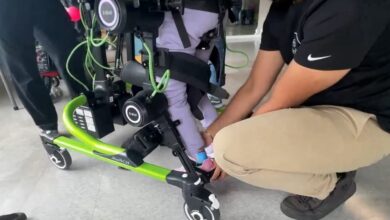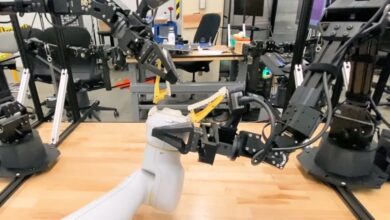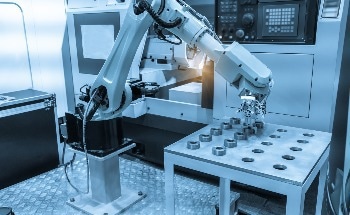Silicon Valley startup Formic pioneers the robotics-as-a-service market

Formic founder Saman Farid’s years working at billion-dollar brand companies including Amazon, Honeywell, Microsoft and Verizon, as well as almost 15 years spent in China deploying robots and building manufacturing facilities across a variety sectors, has given him a macro view on how robotics technology can impact productivity.
With experience as a venture capitalist building software companies at the intersection of AI and machine learning with the physical world, Farid is somewhat of a generalist with specialist experience of the robotics industry. He has been known to joke with his team that he’s the CEO slash head janitor. “That’s just the job” he quips.
And while robotics has been around for a while, AI and cloud computing are unlocking its true potential by enabling seamless and uninterrupted access to vast amounts of data. These technology developments, in addition to market forces, have seen the robotics industry grow rapidly. According to GlobalData forecasts, the industry was worth $63bn in 2022, and by 2030, it will have grown at a compound annual growth rate of 17% to $218bn.
Cloud robotics is still in its early stages of development and adoption but connecting robot data to a cloud platform, and sharing the data it collects with other robots on the same platform has profound potential to change business and industrial processes. According to GlobalData’s 2023 robotics thematic intelligence report, while this trend is still at an early stage of development, the emergence of cloud platforms and infrastructure as a reliable, scalable, and easily deployed computing source will be a key driver for the industry.
Within this wider market, Farid recognised the benefits of robotics technology for SMEs, but became frustrated by the pace of adoption in the real world. “I’m sure you’ve heard the saying that the future is here, but it’s not evenly distributed yet,” he says, adding: “That really resonated with me because I saw robotics technology advance very quickly in places like Silicon Valley but not in the vast majority of manufacturing facilities that needed it.”
And this was the inspiration behind building a company like Formic to give SME’s an easy path to adoption of robotics technology.
Robotics-as-a-service hold huge value for SMEs
Formic has an office in Oakland, California, and another in Chicago to serve the company’s predominantly mid-western customers, and where the vast majority of Formic’s deployment and maintenance staff are based. From there, staff can service customers in Ohio, Wisconsin, Illinois, and parts of Michigan. In addition, the company has deployment technicians spread across the country in New York, New Jersey, Pennsylvania, Southeast Carolina and Texas among others.
Formic is very much pioneering the robotics-as-a-service (RaaS) market, a market with huge potential to serve companies unable to invest in equipment and expertise from the get-go. “It’s necessary to know how to manage the equipment and what to buy, how to maintain it,” says Farid.
The majority of manufacturing facilities in the US are 30 to 40%, understaffed. In addition, many factories have a high headcount turnover 20 to 30% per month. This means businesses are already struggling to keep up with production demand. “They simply don’t have the time to become robotics experts in-house, they don’t know what to buy, how to manage it, how to maintain it, how to program it,” says Farid.
RaaS takes away all the complexity and risk, as well as the need for maintenance by deploying robots at an hourly rate so that businesses just pay for the performance they need. “We’re on the hook for all of the service and maintenance, the software upgrades,” says Farid.
Huge market potential for robotics-as-a-service
Only a handful of companies currently provide such a full-service, ongoing performance commitment with guarantees that mean businesses that previously could not justify the costs have been able to harness the new technology.
Farid shares the example of a chocolate chip cookie maker customer. “They are world experts in making chocolate chip cookies taste good, so dedicating staff to figure out how to make a robot to work is really a distraction from their core capabilities,” he explains.
The robots are good at peripheral tasks like packaging the product, putting boxes onto pallets and all the other highly repetitive, tasks that are painful for humans. This unburdening of peripheral tasks can often unlock greater productivity for a company’s core business, like making chocolate chip cookies.
Formic builds AI tools to manage the manufacturing process remotely. The company can invest in R&D to finesse these processes, something an SME would not be able to do. “And because we’re so we’re managing robots in more than 100 manufacturing facilities, we’re able to apply efficiencies to everybody at scale,” says Farid.
RaaS can monitor product quality and production performance rates, feeding back data to help a business inform their decision-making for upstream processing. This ability to harvest production data is increasingly becoming a part of the RaaS offering. “A lot of our customers initially work with us on specific tasks, then the data insights start to flow and they use that data to make better decisions,” says Farid.
While Formic is constantly using new kinds of robots and developing technologies, in its deployments, the robot hardware itself is not necessarily the cutting edge of development. “It’s the software that runs on robot, that them more safe, more collaborative and intelligent, flexible and adaptive and all those things are constantly changing,” says Farid.
In May this year, Formic announced it had surpassed 100,000 hours of production, a very big milestone for the startup which demonstrates the meaningful impact Formic is having in manufacturing facilities.
SMEs should consider robotics-as-a-service
Farid’s advice to SME’s exploring robotics is to first identify what is worth automating. Things people think are easy for robots to do are actually quite hard. And the things that are easy for humans to do, may not be that are easy for robots to do. For example, dexterous tasks like filling a bag with product and shaking it a little bit, is relatively easy for a human but highly complex for a robot.
In contrast, stacking a pallet with huge heavy boxes is easy for a robot and risky for a human. Businesses need to differentiate between the two and identify backbreaking, painful and highly repetitive, tasks for which robots are generally much more robust.
When pressed on the ethical implications of replacing human work with robots, Farid points to research that demonstrates that factories with automation and robots actually end up hiring more people because they become more competitive, productive and global.
The typical factory in America today only runs about 2,000 hours per year out of 8,600 possible production hours, according to Farid. “That means that most factories are sitting idle, every forklift, machine and truck sits idle 75% of the time which means that, naturally, these factories are then much less competitive globally,” he says.
With increased throughput and production using robotics, these companies can reach a lower cost per produced unit, which results in winning more business, becoming more profitable and competing in a global marketplace. Formic has a global outlook. And while Formic currently operates exclusively in the US, Farid says the company plans to expand globally soon, expanding the RaaS model across the world.
“Interview: Silicon Valley startup Formic pioneers the robotics-as-a-service market” was originally created and published by Verdict, a GlobalData owned brand.
The information on this site has been included in good faith for general informational purposes only. It is not intended to amount to advice on which you should rely, and we give no representation, warranty or guarantee, whether express or implied as to its accuracy or completeness. You must obtain professional or specialist advice before taking, or refraining from, any action on the basis of the content on our site.



